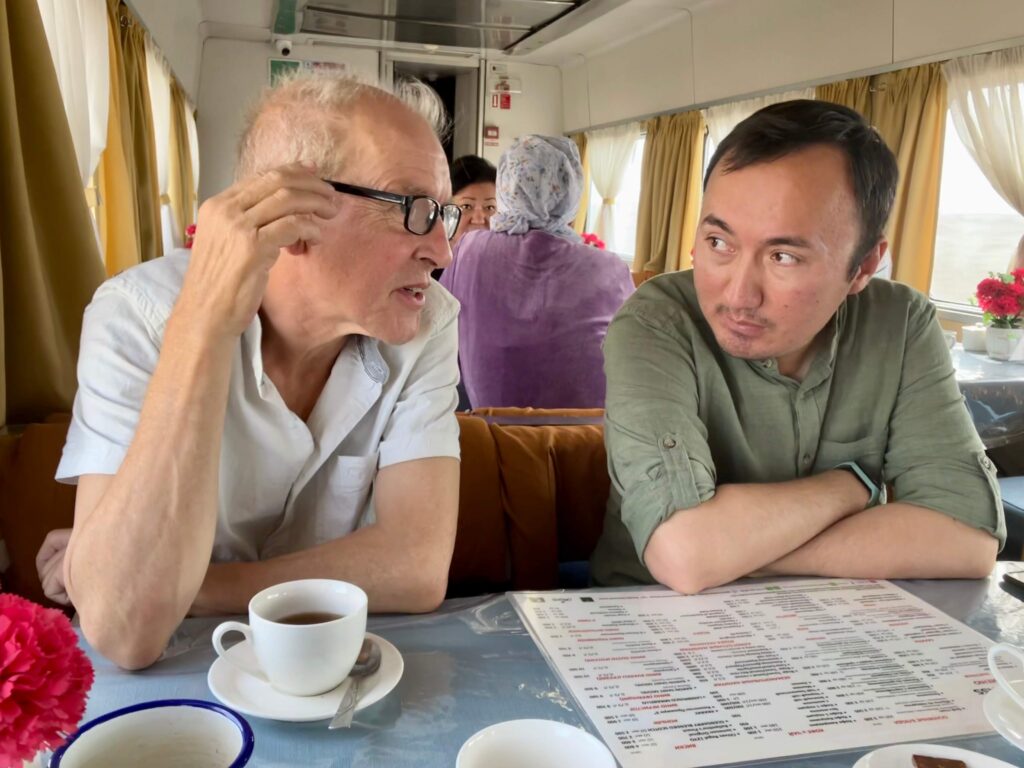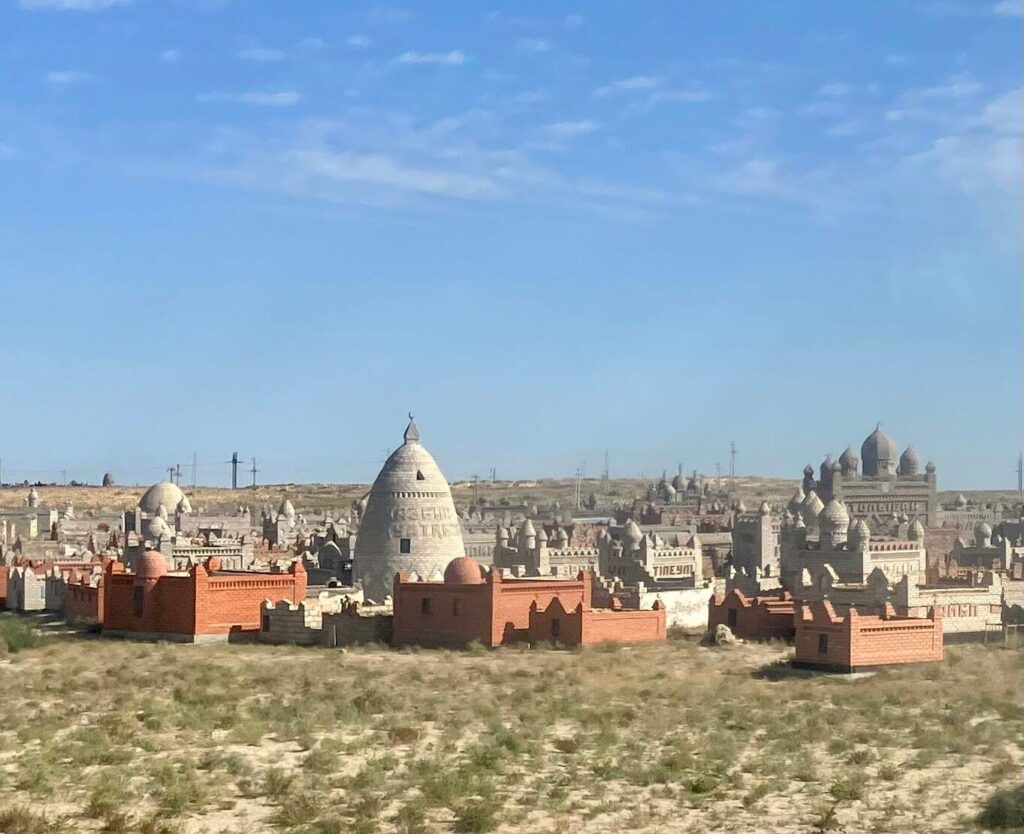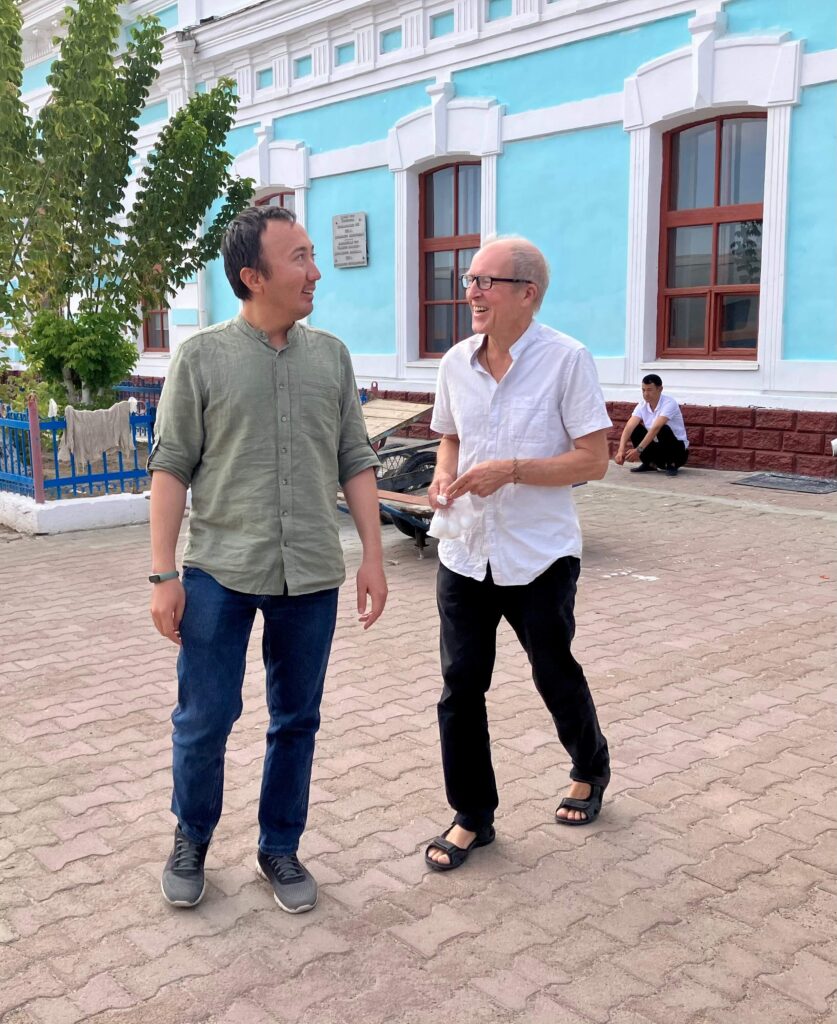Riding with the sons of Genghis Khan - Theo’s blog
(By the time this post is up, we should be finally heading to the Chinese border!)
The prospect for our 2 day train trek across the Steppes of Kazakhstan was not looking so great. I’d been placed in a separate compartment from Shan and Rosa; The cabins of our allegedly “modern” carriages were cramped and awkward, compared to the Soviet-era sleeper from Astrakhan, and unlike the latter carriages, had no hot water boilers for tea; The windows were sealed but the air con was poor; My upper bunk had no window view; And out of respect for Larissa, our devout Muslim passenger, the 3 men in the cabin had to leave and stand in the corridor 3 times a day when her phone alert called her to prayer.
But once I got chatting with the English-speaking Kazakh man opposite me, the otherwise challenging journey became a fascinating travelogue and introduction to the country, and he touched my heart – not necessarily with hope for the future, but with hope for how we can connect with each other across different cultures and histories.
Abylai worked in Kazakhstan’s oil and gas fields, and he was on his way home after a 28 day stint. His fuller name was Abylaihkan, the Khan bit being his tribal name as a descendant from the tribe of Genghis Khan. There are at least 22 native Kazakh tribes, and apparently everyone knows their lineage back at least for 7 generations. He lived with his aging mum and dad because it’s the sons duty to care for them. He’d already found out that the other man in our carriage was also a Khan, and he told me there’s a certain obligation to these relations, however distant.
I was riding across the steppes of Kazakhstan with two sons of Genghis Khan!
But it’s a long time since his people were the yurt-living nomads of the Steppes. The vast majority now live in towns and burgeoning cities as the country grows richer from the oil pumping out to the rest of us. When I ask him why that wealth hasn’t gone into basics like clean tap water in the working class city of Atyrau where it was too filthy to drink, he looks unhappy, “It’s a problem. But not in the richer neighbourhoods.” But then he spreads his hands in resignation, “But what can we do, we have no choices”. It’s something he says repeatedly during or conversations. The democracy doesn’t really function, the same old guard stay in power, and political opposition is sidelined or violently repressed. And the oil is not owned by the Kazakh people, or even the Kazakh elite, who he accuses of theft and corruption.
In the oil field he has just been working, 50% is owned by Chevron, 25% by Exxon, 5% by the Russian transporters, and 20% by KZ. Half the higher paid contractors and employees he works with are not Kazakh, many are Irish, Scottish and English, as well as American, southeast Asian and Nigerian. But still, this globalised fossil-fuel extraction business has brought modernity and a reasonable income into his life.
As we trundle through the massive scrubby desert, me hoping to glimpse the two-humped Bactrian camels which to Abylai are just livestock for meat, he explains that this whole vast plain was once a seabed. That’s when the oil was laid down beneath it, over millions of years. The seas eventually went, leaving only the massive inland Aral Sea. I say massive, because it WAS when I was a teenager – larger than Tasmania or Sri Lanka. Now it’s wildlife and livelihoods have disappeared, tragically shrunk and depleted in less than 5 decades to the size of Somerset, after rivers were diverted for farming and industry under Kazakhstans former rulers, the USSR. As the train passes near where its shores used to be, Abylai shows me the white expanses of salt that render the land barren even for the hardy desert shrubs.
But other, new lakes have been created further east – radioactive ones. Abylai tells me that this is where the former soviet rulers performed over 500 nuclear tests, even trying to use them to redirect rivers so that the water would flow to Russia. As a result , according to him, there are still poisoned animals, and children born with birth defects to parents who fish and drink from the water.
I hadn’t realised how chronically the land of this country had been abused by its western neighbours, seen no doubt as a huge empty wasteland where risky experiments could be performed and locals pushed aside. It was the Csarist Russian empire that first colonised here, and there are some fine Station buildings to show for it. Russians were given fertile land near the mountains to farm and later, under Stalin, thousands of political prisoners and displaced peoples were sent here too. So there’s a lot of Russian Kazakhs as well as ethnic.
Further down the track, sitting in the restaurant car with a pot of tea, we can just see the Russian “space city”, Baikonur, and the Russian “Cosmodrome”, the home of Russian Space missions. This was the launch pad for the first human in space, built by the USSR, and the whole area, land and city, is still leased from Kazakhstan as a Russian territory. All very thrilling and space-age, until I hear about the shedding of debris and toxic space fuel which have killed wildlife, contaminated the Steppe, caused human cancer epidemics under the flight paths, and are implicated in the mass die off of endangered Taiga antelope herds in 2015. Again, when Abylai tells me these things, it’s with a sadness under a tone of hopeless resignation. He has no faith in things changing or people being held accountable. But this toxic history of negligence doesn’t stop him from seeming, like other native Kazakhs we meet, basically happy in his own skin and at ease with others.
We’re standing in the carriage corridor while Larissa prays again, watching the land beginning to green as we head south, when I see him salute a graveyard we pass and bow his head. He explains it’s where his grandparents are buried. The cemetry has little miniature palaces and clay domes, which Abylai says are a unique Kazakh feature, arising from their nomadic heritage, because the homes of the dead are also there as open shelters for any living travellers passing by. There’s something pretty poetic in that. It makes me think of the Neolithic homes near Konya, Turkey, with the dead buried under the living room floor, and the poems of Rumi in his tomb nearby.
As we slow down to enter his home town of Kyzylorda, he shows me the rice factory where he had his first job, and we laugh about the “illegal tobacco” that gets secretly grown among the rice plants. On the outskirts there’s an old Soviet cardboard factory in disrepair because there aren’t enough trees and the new Chinese glass factory which could represent some kind of future for a country full of sand. There’s lithium in the hills as well. So the future of Kazakhstan looks to be more mineral extraction of one kind or another. It’s hard to say what else they’ve got, although once we reached the south east nearer the mountains that border China and Kyrgyzstan, the land was fertile and food growing abundant. Abylai even had a note of caution about that, since the glaciers are shrinking as the population grows, and the seasons are getting drier. He’s well aware that that’s connected to burning the fossil fuels his livelihood depends on. He hopes that he can start some kind of import/export trading with China in the future.
I said goodbye to my new friend on the platform. The train stops were usually long enough to buy fresh fruit and breads from local stalls. We had a hug. For some reason we felt very close to each other, and well-met. After I’d got back on the train he suddenly reappeared with gifts of fresh fruit and bread which he gave to Shannon. A lovely man, acutely aware of his country’s predicament, which is everyone’s predicament now.




So lovely to have met someone willing to guide you through the long train journey. It’s a privilege to hear his stories through you and to glimpse the culture of Kazakhstan. Good luck with the Chinese border crossing. Xxx
Fascinating and you write really well! I wanted to do this trip since 1968, when the world and this area were very different. I can’t do it now, but Philippa and I make up for it with reading. Being good at languages, she is teaching herself Chinese, and finds the medium of poetry extremely helpful. I’ve mentioned Du Fu, but also love Hanshan, Cold Mountain. I also recently ploughed through ‘Wild Swans’, the most gruelling but compelling account of life in the Mao era – not dissimilar from the Imperial era – yet relevant I would think for understanding China today. Indeed, what the CCP inflicted on the Chinese, is now being inflicted on the Uyghurs (and the Tibetans) whose territory you may be passing through now. Don’t get out your camera!
I’ve been catching up with all your news this evening. Your posts are just amazing, all of you. You bring everything to life and it’s as if we are travelling with you in some ways. So good you got to see camels, Shannon and also that you’re better now. Cat therapy must have helped! The pancake lady looked lovely and Abylai sounds like a really special person. Good luck in China. Looking forward to the next instalments! Huge hugs and loads of love to you all.
What an interesting person to meet! There are some people that we make an immediate and deep connection with-quite randomly! Good luck in China-looking forward to hearing all about it! Hope you are feeling better now Shannon XX